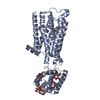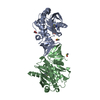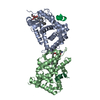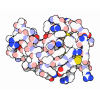+ Open data
Open data
- Basic information
Basic information
| Entry | Database: PDB / ID: 4u16 | ||||||
|---|---|---|---|---|---|---|---|
| Title | M3-mT4L receptor bound to NMS | ||||||
 Components Components | Muscarinic acetylcholine receptor M3,Lysozyme,Muscarinic acetylcholine receptor M3 | ||||||
 Keywords Keywords |  MEMBRANE PROTEIN/INHIBITOR / GPCR Crystallography T4 lysozyme / MEMBRANE PROTEIN/INHIBITOR / GPCR Crystallography T4 lysozyme /  MEMBRANE PROTEIN-INHIBITOR complex MEMBRANE PROTEIN-INHIBITOR complex | ||||||
| Function / homology |  Function and homology information Function and homology informationnegative regulation of heart rate by acetylcholine / G protein-coupled acetylcholine receptor binding /  Muscarinic acetylcholine receptors / regulation of vascular associated smooth muscle contraction / saliva secretion / quaternary ammonium group binding / ion channel modulating, G protein-coupled receptor signaling pathway / phospholipase C-activating G protein-coupled acetylcholine receptor signaling pathway / response to acetylcholine / G protein-coupled acetylcholine receptor activity ...negative regulation of heart rate by acetylcholine / G protein-coupled acetylcholine receptor binding / Muscarinic acetylcholine receptors / regulation of vascular associated smooth muscle contraction / saliva secretion / quaternary ammonium group binding / ion channel modulating, G protein-coupled receptor signaling pathway / phospholipase C-activating G protein-coupled acetylcholine receptor signaling pathway / response to acetylcholine / G protein-coupled acetylcholine receptor activity ...negative regulation of heart rate by acetylcholine / G protein-coupled acetylcholine receptor binding /  Muscarinic acetylcholine receptors / regulation of vascular associated smooth muscle contraction / saliva secretion / quaternary ammonium group binding / ion channel modulating, G protein-coupled receptor signaling pathway / phospholipase C-activating G protein-coupled acetylcholine receptor signaling pathway / response to acetylcholine / G protein-coupled acetylcholine receptor activity / positive regulation of vascular associated smooth muscle contraction / adenylate cyclase-inhibiting G protein-coupled acetylcholine receptor signaling pathway / positive regulation of smooth muscle contraction / G protein-coupled serotonin receptor activity / Muscarinic acetylcholine receptors / regulation of vascular associated smooth muscle contraction / saliva secretion / quaternary ammonium group binding / ion channel modulating, G protein-coupled receptor signaling pathway / phospholipase C-activating G protein-coupled acetylcholine receptor signaling pathway / response to acetylcholine / G protein-coupled acetylcholine receptor activity / positive regulation of vascular associated smooth muscle contraction / adenylate cyclase-inhibiting G protein-coupled acetylcholine receptor signaling pathway / positive regulation of smooth muscle contraction / G protein-coupled serotonin receptor activity /  synaptic transmission, cholinergic / synaptic transmission, cholinergic /  acetylcholine binding / G alpha (q) signalling events / acetylcholine receptor signaling pathway / ligand-gated ion channel signaling pathway / G protein-coupled receptor signaling pathway, coupled to cyclic nucleotide second messenger / asymmetric synapse / smooth muscle contraction / axon terminus / positive regulation of vasoconstriction / viral release from host cell by cytolysis / peptidoglycan catabolic process / basal plasma membrane / calcium-mediated signaling / postsynaptic density membrane / G protein-coupled acetylcholine receptor signaling pathway / positive regulation of insulin secretion / cell wall macromolecule catabolic process / acetylcholine binding / G alpha (q) signalling events / acetylcholine receptor signaling pathway / ligand-gated ion channel signaling pathway / G protein-coupled receptor signaling pathway, coupled to cyclic nucleotide second messenger / asymmetric synapse / smooth muscle contraction / axon terminus / positive regulation of vasoconstriction / viral release from host cell by cytolysis / peptidoglycan catabolic process / basal plasma membrane / calcium-mediated signaling / postsynaptic density membrane / G protein-coupled acetylcholine receptor signaling pathway / positive regulation of insulin secretion / cell wall macromolecule catabolic process /  lysozyme / lysozyme /  presynaptic membrane / presynaptic membrane /  lysozyme activity / chemical synaptic transmission / basolateral plasma membrane / host cell cytoplasm / defense response to bacterium / glutamatergic synapse / lysozyme activity / chemical synaptic transmission / basolateral plasma membrane / host cell cytoplasm / defense response to bacterium / glutamatergic synapse /  synapse / synapse /  dendrite / endoplasmic reticulum membrane / dendrite / endoplasmic reticulum membrane /  plasma membrane plasma membraneSimilarity search - Function | ||||||
| Biological species |   Rattus norvegicus (Norway rat) Rattus norvegicus (Norway rat)  Enterobacteria phage T4 (virus) Enterobacteria phage T4 (virus) | ||||||
| Method |  X-RAY DIFFRACTION / X-RAY DIFFRACTION /  SYNCHROTRON / SYNCHROTRON /  MOLECULAR REPLACEMENT / Resolution: 3.7 Å MOLECULAR REPLACEMENT / Resolution: 3.7 Å | ||||||
 Authors Authors | Thorsen, T.S. / Matt, R. / Weis, W.I. / Kobilka, B. | ||||||
 Citation Citation |  Journal: Structure / Year: 2014 Journal: Structure / Year: 2014Title: Modified T4 Lysozyme Fusion Proteins Facilitate G Protein-Coupled Receptor Crystallogenesis. Authors: Thorsen, T.S. / Matt, R. / Weis, W.I. / Kobilka, B.K. | ||||||
| History |
|
- Structure visualization
Structure visualization
| Structure viewer | Molecule:  Molmil Molmil Jmol/JSmol Jmol/JSmol |
|---|
- Downloads & links
Downloads & links
- Download
Download
| PDBx/mmCIF format |  4u16.cif.gz 4u16.cif.gz | 315 KB | Display |  PDBx/mmCIF format PDBx/mmCIF format |
|---|---|---|---|---|
| PDB format |  pdb4u16.ent.gz pdb4u16.ent.gz | 254.7 KB | Display |  PDB format PDB format |
| PDBx/mmJSON format |  4u16.json.gz 4u16.json.gz | Tree view |  PDBx/mmJSON format PDBx/mmJSON format | |
| Others |  Other downloads Other downloads |
-Validation report
| Arichive directory |  https://data.pdbj.org/pub/pdb/validation_reports/u1/4u16 https://data.pdbj.org/pub/pdb/validation_reports/u1/4u16 ftp://data.pdbj.org/pub/pdb/validation_reports/u1/4u16 ftp://data.pdbj.org/pub/pdb/validation_reports/u1/4u16 | HTTPS FTP |
|---|
-Related structure data
| Related structure data |  4u14C  4u15C  4dajS  4lzmS C: citing same article ( S: Starting model for refinement |
|---|---|
| Similar structure data |
- Links
Links
- Assembly
Assembly
| Deposited unit | 
| ||||||||
|---|---|---|---|---|---|---|---|---|---|
| 1 | 
| ||||||||
| 2 | 
| ||||||||
| Unit cell |
| ||||||||
| Details | biological unit is the same as asym. |
- Components
Components
| #1: Protein | Mass: 47858.023 Da / Num. of mol.: 2 Fragment: UNP P08483 residues 57-259, 482-563, UNP D9IEF7 residues 61-161 Source method: isolated from a genetically manipulated source Source: (gene. exp.)   Rattus norvegicus (Norway rat), (gene. exp.) Rattus norvegicus (Norway rat), (gene. exp.)   Enterobacteria phage T4 (virus) Enterobacteria phage T4 (virus)Gene: Chrm3, Chrm-3, e, T4Tp126 / Production host:   Spodoptera frugiperda (fall armyworm) / References: UniProt: P08483, UniProt: D9IEF7, Spodoptera frugiperda (fall armyworm) / References: UniProt: P08483, UniProt: D9IEF7,  lysozyme lysozyme#2: Chemical |  Tartaric acid Tartaric acid#3: Chemical |  Methylscopolamine bromide Methylscopolamine bromideSequence details | The fusion protein is a chimeric of M3 and RB69 lysozyme. The fusion protein is made of M 3 ( ...The fusion protein is a chimeric of M3 and RB69 lysozyme. The fusion protein is made of M 3 ( residues 57-259) - Lysozyme (residues 1000-1117)- M3 (residues 482-563). | |
|---|
-Experimental details
-Experiment
| Experiment | Method:  X-RAY DIFFRACTION / Number of used crystals: 1 X-RAY DIFFRACTION / Number of used crystals: 1 |
|---|
- Sample preparation
Sample preparation
| Crystal | Density Matthews: 4.24 Å3/Da / Density % sol: 70.96 % |
|---|---|
Crystal grow | Temperature: 293 K / Method: lipidic cubic phase Details: The best crystallization condition was 100 mM Tris pH 7.5, 44% PEG 300 and 400 mM ammonium tartrate. |
-Data collection
| Diffraction | Mean temperature: 80 K |
|---|---|
| Diffraction source | Source:  SYNCHROTRON / Site: SYNCHROTRON / Site:  APS APS  / Beamline: 23-ID-D / Wavelength: 1.033 Å / Beamline: 23-ID-D / Wavelength: 1.033 Å |
| Detector | Type: MARMOSAIC 300 mm CCD / Detector: CCD / Date: Mar 16, 2013 |
| Radiation | Protocol: SINGLE WAVELENGTH / Monochromatic (M) / Laue (L): M / Scattering type: x-ray |
| Radiation wavelength | Wavelength : 1.033 Å / Relative weight: 1 : 1.033 Å / Relative weight: 1 |
| Reflection | Resolution: 3.7→33.7 Å / Num. obs: 14787 / % possible obs: 93.7 % / Redundancy: 2.6 % / Biso Wilson estimate: 119.14 Å2 / Rmerge(I) obs: 0.219 / Net I/σ(I): 8.9 |
| Reflection shell | Resolution: 3.7→3.83 Å / Redundancy: 2.5 % / Rmerge(I) obs: 0.884 / Mean I/σ(I) obs: 2.2 / % possible all: 89.1 |
- Processing
Processing
| Software |
| ||||||||||||||||||||||||||||||||||||||||||
|---|---|---|---|---|---|---|---|---|---|---|---|---|---|---|---|---|---|---|---|---|---|---|---|---|---|---|---|---|---|---|---|---|---|---|---|---|---|---|---|---|---|---|---|
| Refinement | Method to determine structure : :  MOLECULAR REPLACEMENT MOLECULAR REPLACEMENTStarting model: 4DAJ, 4LZM Resolution: 3.7→33.67 Å / SU ML: 0.59 / Cross valid method: FREE R-VALUE / σ(F): 1.36 / Phase error: 34.09 / Stereochemistry target values: ML
| ||||||||||||||||||||||||||||||||||||||||||
| Solvent computation | Shrinkage radii: 0.9 Å / VDW probe radii: 1.11 Å / Solvent model: FLAT BULK SOLVENT MODEL | ||||||||||||||||||||||||||||||||||||||||||
| Refinement step | Cycle: LAST / Resolution: 3.7→33.67 Å
| ||||||||||||||||||||||||||||||||||||||||||
| Refine LS restraints |
| ||||||||||||||||||||||||||||||||||||||||||
| LS refinement shell |
| ||||||||||||||||||||||||||||||||||||||||||
| Refinement TLS params. | Method: refined / Origin x: -37.3762 Å / Origin y: -1.074 Å / Origin z: 5.547 Å
| ||||||||||||||||||||||||||||||||||||||||||
| Refinement TLS group | Selection details: all |
 Movie
Movie Controller
Controller













 PDBj
PDBj













